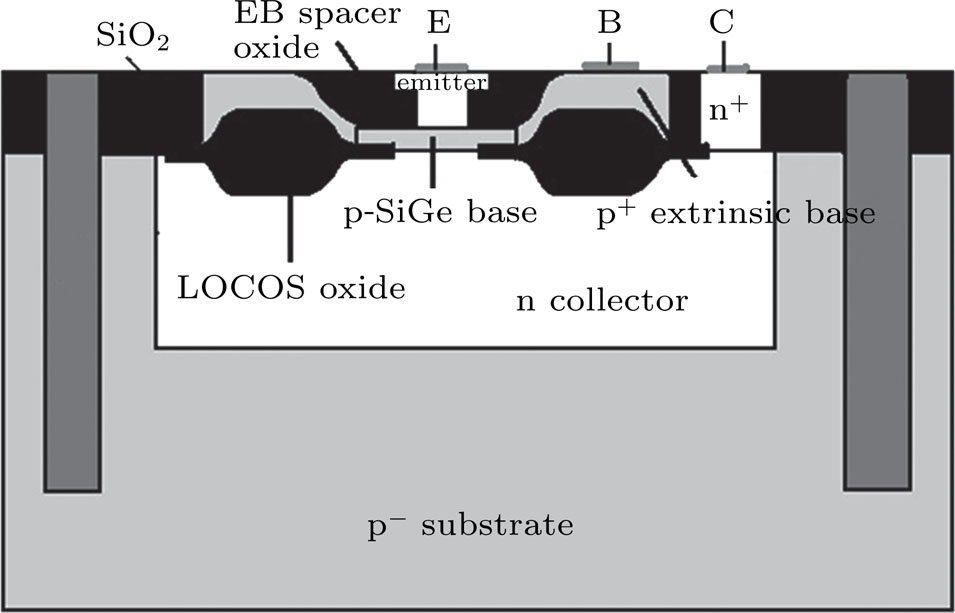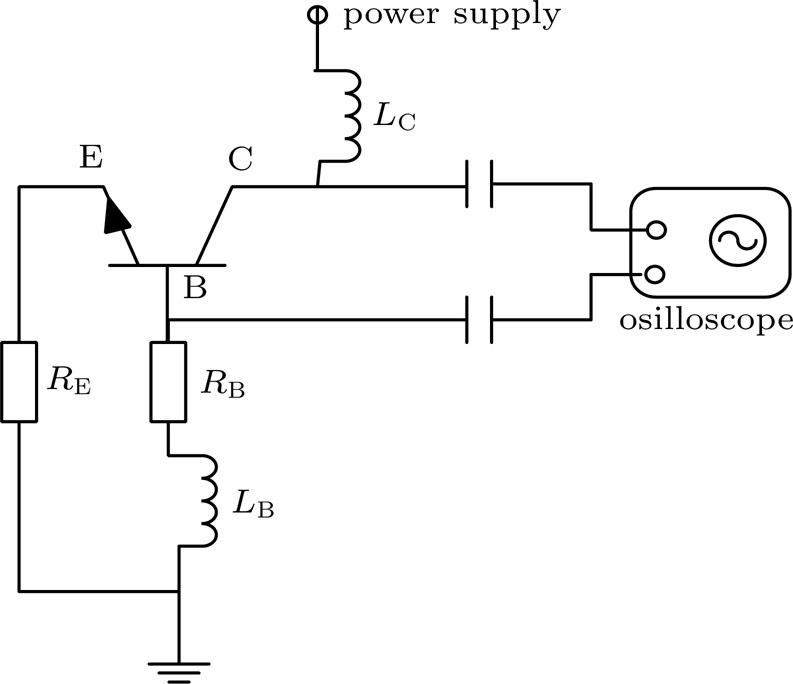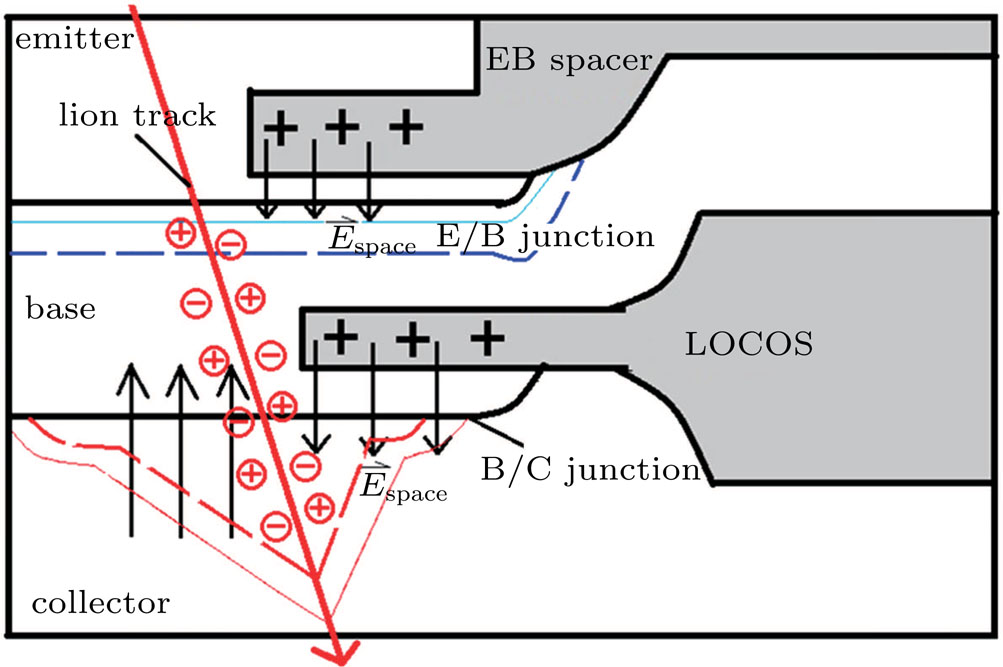† Corresponding author. E-mail:
The synergistic effect of total ionizing dose (TID) on single event effect (SEE) in SiGe heterojunction bipolar transistor (HBT) is investigated in a series of experiments. The SiGe HBTs after being exposed to 60Co γ irradiation are struck by pulsed laser to simulate SEE. The SEE transient currents and collected charges of the un-irradiated device are compared with those of the devices which are irradiated at high and low dose rate with various biases. The results show that the SEE damage to un-irradiated device is more serious than that to irradiated SiGe HBT at a low applied voltage of laser test. In addition, the γ irradiations at forward and all-grounded bias have an obvious influence on SEE in the SiGe HBT, but the synergistic effect after cutting off the γ irradiation is not significant. The influence of positive oxide-trap charges induced by TID on the distortion of electric field in SEE is the major factor of the synergistic effect. Moreover, the recombination of interface traps also plays a role in charge collection.
Silicon–germanium heterojunction bipolar transistor (SiGe HBT), as a typical device of band gap engineering based silicon, not only possesses competitive high-speed and high-frequency capability, but also has a good integration with Si CMOS technology.[1,2] Particularly, SiGe HBT can operate in extreme environment (−180 °C ∼ +200 °C) especially at cryogenic temperature because of the band gap gradient of the base region.[3–5] Therefore, SiGe HBTs as active devices are possibly used outside the spacecraft, so that the volume and weight of the electronic system and launch costs will be greatly reduced.[6] The SiGe HBT has become a potential competitor in the space field. However, the electronic equipment outside the spacecraft will be placed in the complex space environment, which is composed of diverse particles and cosmic rays. Thus, the radiation damage shows a synergistic mechanism under the combined action of total ionizing dose (TID), single event effect (SEE), and displacement damage (DD).
The SiGe HBT has been demonstrated to have good tolerance of displacement damage, but it is very vulnerable to single-event effects.[7–9] In addition, our previous work found that the TID irradiation did not cause significant failure on the SiGe HBT, but showed complicated responses under different bias conditions.[10,11] In this case, the synergistic effect of TID on SEEs becomes a key issue for the space applications of SiGe HBTs. Nevertheless, at present, the anti-radiation capability of SiGe HBTs is mainly evaluated by independent tests based on different radiation effects. The synergistic radiation effect of SiGe HBT is rarely reported.
Based on our previous studies, in this paper the synergistic effect is investigated via a microbeam laser experiment to simulate SEE after TID tests by the irradiation of 60Co γ on the SiGe HBTs. The transient current and the charge collection of the γ irradiated SiGe HBT with various biases are analyzed in order to discuss the mechanism of the influence of trapping defects induced by TID on the SEE. The results present some interesting phenomena and provide new ideas of radiation hardening technology.
Figure 


In order to investigate the mechanism of the synergistic effect, six SiGe HBT devices irradiated by 60Co γ and an un-irradiated device are chosen as samples for microbeam laser experiment. Three of these samples had been irradiated at a high dose rate of 80 rad(Si)/s, and set to be under three different biases in the irradiation exposure: (i) forward bias: VBE = 0.8 V, VBC = −1.8 V; (ii) cutoff bias: VBE = 0 V, VBC = −2 V; (iii) all-grounded bias: VE = VB = VC = 0 V. Other three samples are subjected to low dose rate irradiation with 0.1 rad(Si)/s under the same bias conditions. The TID tests are performed at the 3×106-Ci (1 Ci = 3.7×1010 Bq) 60Co γ-ray source platform in Xinjiang Technical Institute of Physics & Chemistry, Chinese Academy of Sciences. The total ionizing dose accumulates 1 Mrad(Si) in high and low dose rate irradiation.
The SEE test of the synergistic effect in the SiGe HBT is conducted by the pulsed laser microbeam system whose model is EKSMA PL2143 in the Northwest Institute of Nuclear Technology. The pulse width of the picoseconds laser is 25 ps that is similar to the characteristic time of SEE. The wave length is selected as 1064 nm so that the laser can reach the sensitive volume of the device to induce SEE. The spot diameter of the laser beam can be controlled within 
The testing system of the SEE experiment consists of a test circuit and an oscilloscope. The test circuit is shown in Fig.
Because there are only 1 to 3 layers of metal wiring in this SiGe HBT and the struck position can be determined by the device layout, the front of the device is selected to be struck by the laser. Thus, the front packages of all samples are decaped before the experiment. Referring to the SEE sensitive volume of the SiGe HBT obtained in our previous work,[15] a position outside the edge of the interdigital electrode is selected as the point of laser striking, so that the SET signals can be captured, and was not affected by metal wiring. In the above section, we know the substrate did not have a separate electrode in the SiGe HBT. Consequently, the VC = +1.5 V and VC = +3 V are set during the laser irradiation test to form the worst bias under which the C/S junction is inversed. The laser energy is chosen from 0.1 nJ to 30 nJ.
The transient current and collected charges of emitter are too small to be neglected. The SET of the substrate cannot be obtained because the electrode is not individually led out. Therefore, the transient current and collected charges of collector and base are discussed in this paper. In addition, due to the excellent focusing and energy stability of the microbeam laser, the experimental data present good repeatability and identity.
The ionizing of SEE induced by pulsed laser is different from the mechanism of heavy ion, which depends on the Coulomb interaction. When laser energy is greater than the band gap of semiconductor material, electrons will jump from the conduction band to the valence band and the carriers will be ionized by the photoelectric effect. Thus, the microbeam laser that strikes into the SiGe HBT sample ionizes a large number of electron–hole (e–h) pairs along the laser track. However, for the pulsed laser and heavy ion irradiation, the physics processes of charge transport are the same: a potential distortion is produced by the ionized excess carriers so that a funnel electric field is formed at the pn junction. A part of ionized carriers are collected by the drift effect of the funnel electric field, to form a large current transient in a few picoseconds. Subsequently, a large number of charges are further collected through the diffusion mechanism due to the doping gradient in the device.[16]
The TID damage is caused by two kinds of defects, i.e., oxide-trap charge and interface trap.[17] First, some metastable oxide-trap charges are captured by the intrinsic defect in oxide bulk with a shallow energy level and annealed easily. Then, the escaped holes and low probability protons react with SiSiO2 strain bonds in nearly 10 nm range of the SiO2 interface to form stable positive oxide-trap charges with a deep energy level. In addition, hydrogen is released under γ irradiation in the oxide layer, and reacts with the Si dangling bond to form an interface trap.[18–20]
According to the above mechanism, the synergistic effect of TID on SEE in the SiGe HBT is deemed to be dependent on the influences of oxide-trap charges and interface traps on the track of ion (laser) striking. 1) The positive oxide-trap charges of the deep energy level produce a space electric field from the SiO2 layer to the pn junction. As shown in Fig.
For high dose rate irradiation, the holes reach the interface before the protons, and the capture cross-section of the hole is also 1–2 orders of magnitude higher than that of proton. Therefore, these vast positive oxide-trap charges at the Si/SiO2 interface generate an effective space electric field that offsets the SEE funnel potential of the B/C junction and influences the depletion layer of the E/B junction. Meanwhile, the space electric field prevents holes and protons from transporting so that a few interface traps are formed on the other side of the Si/SiO2 interface far from the oxide-trap charges. When these interface traps are located in the region of funnel potential, a few ionized carriers are recombined, and thus reducing the charge collection in SEE. After γ irradiation at the low dose rate, the holes captured by oxygen vacancy decline because excess carriers ionized in the oxide layer are very small per unit of time. Thus, the synergistic effect of the space electric field is relatively weak. In addition, under the weak space electric field, protons have enough time and greater probability to be released so that more interface traps are formed.[21,22] The TID of SiGe HBT is caused by the traps in the EB spacer layer and the beak region of the LOCOS layer. However, the quantity and distribution of oxide-trap charges and interface traps are different in these oxide layers due to the various biases near the pn junctions in γ irradiation as shown in Fig.
The synergistic effect response of transient current and charge collection as a function of laser energy are shown in Figs.
Figures
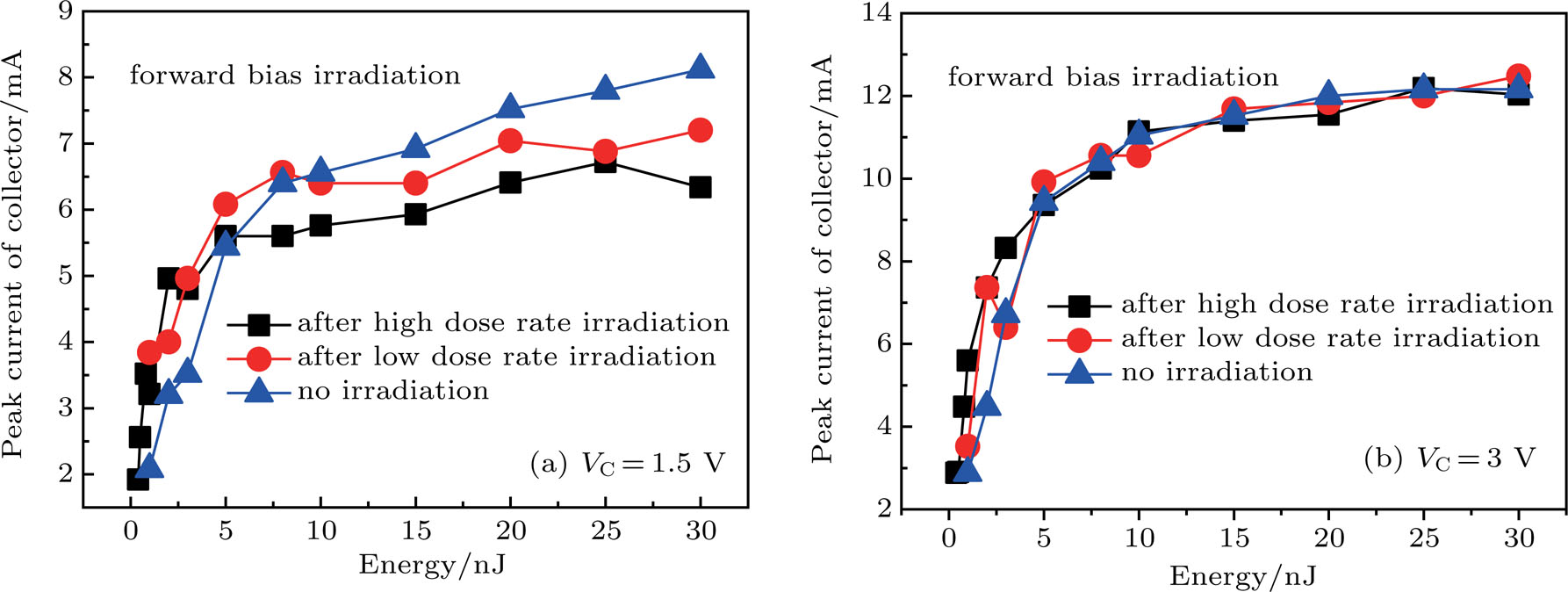 | Fig. 6. (color online) Plots of peak value of transient current versus energy of the collector after being experienced by TID irradiation at forward bias with different dose rates. |
 | Fig. 7. (color online) Plots of peak value of transient current versus energy of collector after being experienced by TID irradiation at cutoff bias with different dose rates. |
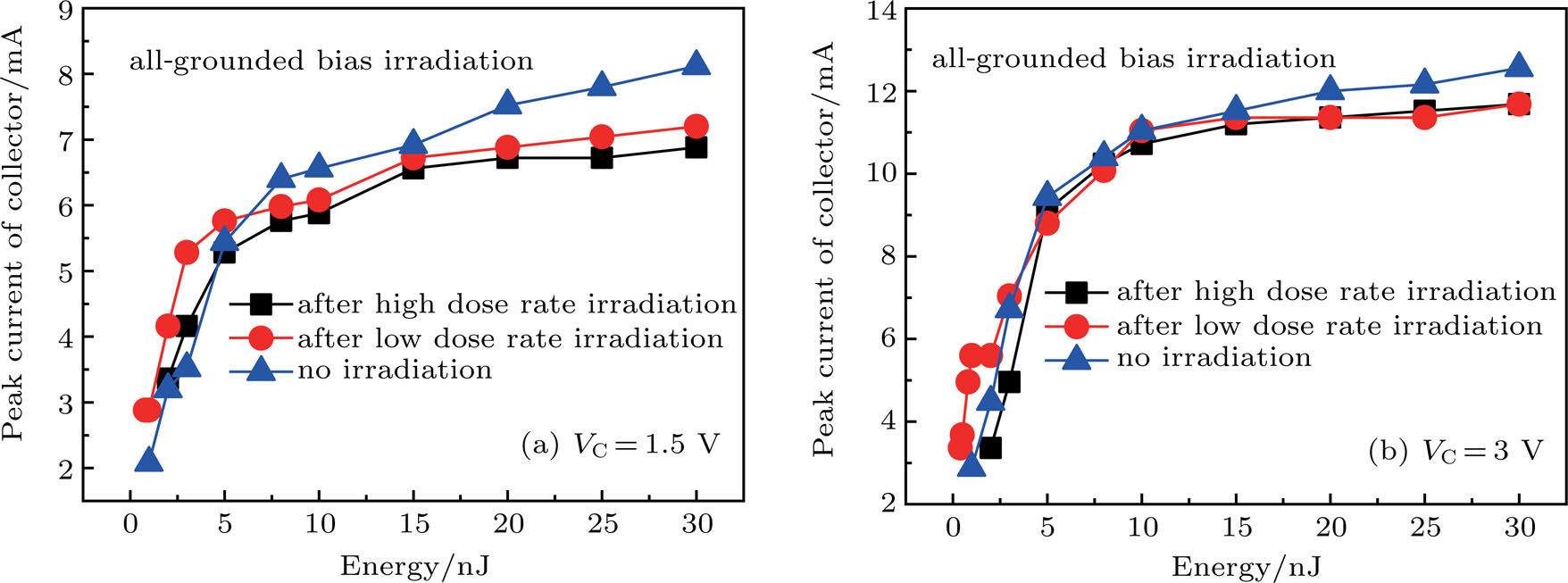 | Fig. 8. (color online) Plots of the peak value of transient current versus energy of the collector after being experienced by TID irradiation at all-grounded bias with different doses. |
In addition, for the pulsed laser test at VC = +1.5 V, the synergistic effect responses are different in the SiGe HBTs that have experienced TID irradiation with various biases: for the forward bias in Fig.
According to our previous work[10] and the device structure shown in Fig.
During γ irradiation, an electric field pointing from collector to base is formed at the B/C junction by the forward bias in the SiGe HBT so that the ionized holes transit towards the base side in the LOCOS and generate stable positive oxide-trap charges near the base, forming space electric field (Fig.
Our previous research[11] shows that the γ irradiation of cutoff bias does not enhance the low dose rate sensitivity (ELDRS) in the SiGe HBT. It is considered that the ionized holes easily produce shallow level oxide-trap charges that are captured by the intrinsic oxygen vacancy in LOCOS during irradiation at cutoff bias (Fig.
When the SiGe HBTs are subjected to TID irradiation at all-grounded bias, the ionized e-h pairs will not be affected by the applied electric field in the oxide layer. Thus during the irradiation and annealing, metastable holes escape from oxygen vacancies and transport slowly to form oxide-trap charges with a deep level in the LOCOS (Fig.
The charge collections of the synergistic effect as a function of laser energy at the collector are given by Figs.
 | Fig. 9. (color online) Plots of charge collection versus energy of collector after TID irradiation at forward bias with different dose rates. |
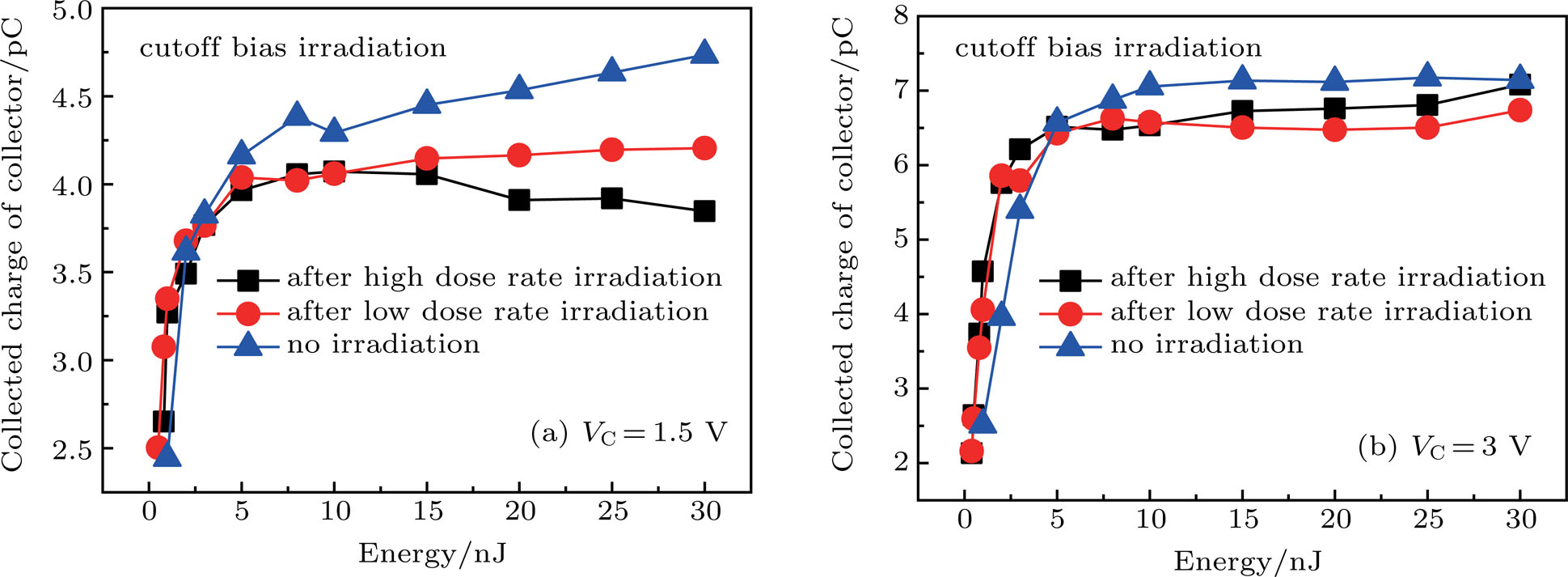 | Fig. 10. (color online) (color online) Plots of charge collection versus energy of collector after TID irradiation at cutoff bias with different dose rates. |
 | Fig. 11. (color online) Plots of charge collection versus energy of collector after being experienced by TID irradiation at all-grounded bias with different dose rates. |
The ELDRS effect of the reverse mode in this SiGe HBT has been demonstrated in Ref. [11]. The interface traps induced by low dose rate irradiation are much more than that by the high dose rate irradiation in LOCOS. However, comparing Figs.
In the high dose rate γ irradiation at forward bias, the positive oxide-trap charges in the LOCOS on the base side prevent the protons from being transported, so the Si–H passivation bonds at the collector/LOCOS interface react with protons to form interface traps, which become the recombination center for diffusion electrons in the collector region (Fig.
The peak values of transient currents as a function of laser energy on the base of SiGe HBTs, which have been irradiated at forward, cutoff, and all-grounded bias are given by Figs.
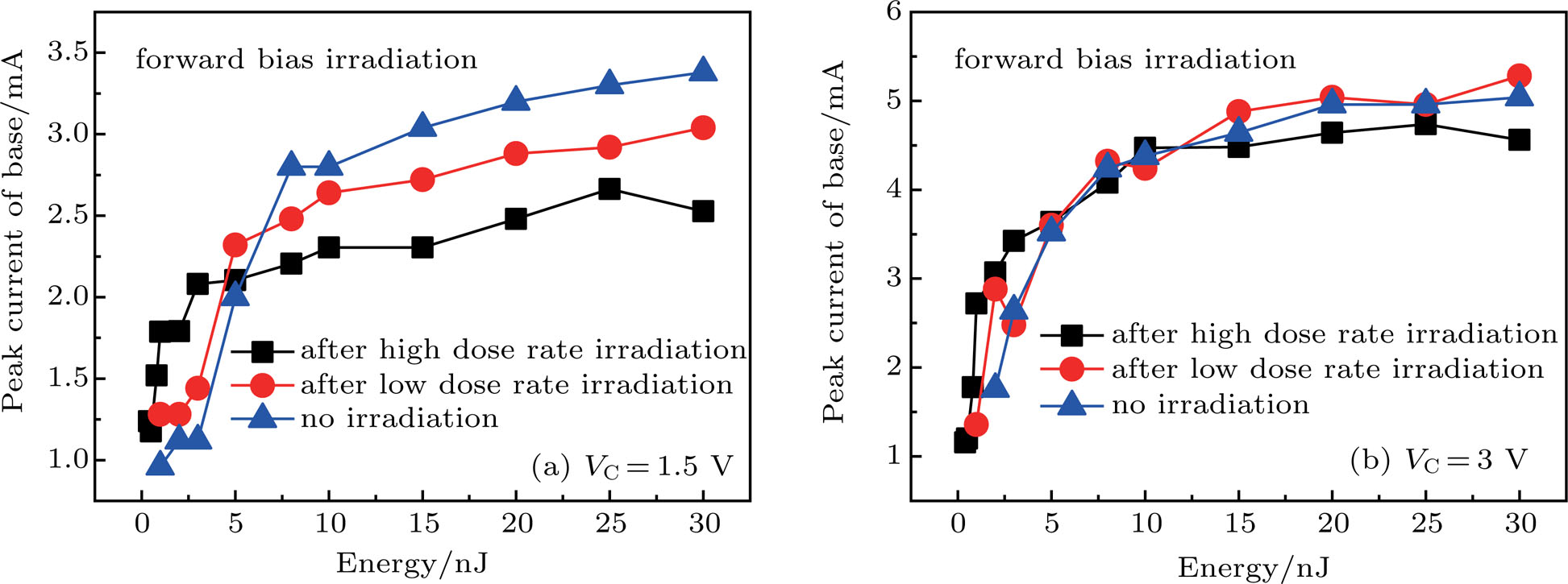 | Fig. 12. (color online) Plots of peak value of transient current of base versus energy of collector after being experienced by TID irradiation at forward bias with different dose rates. |
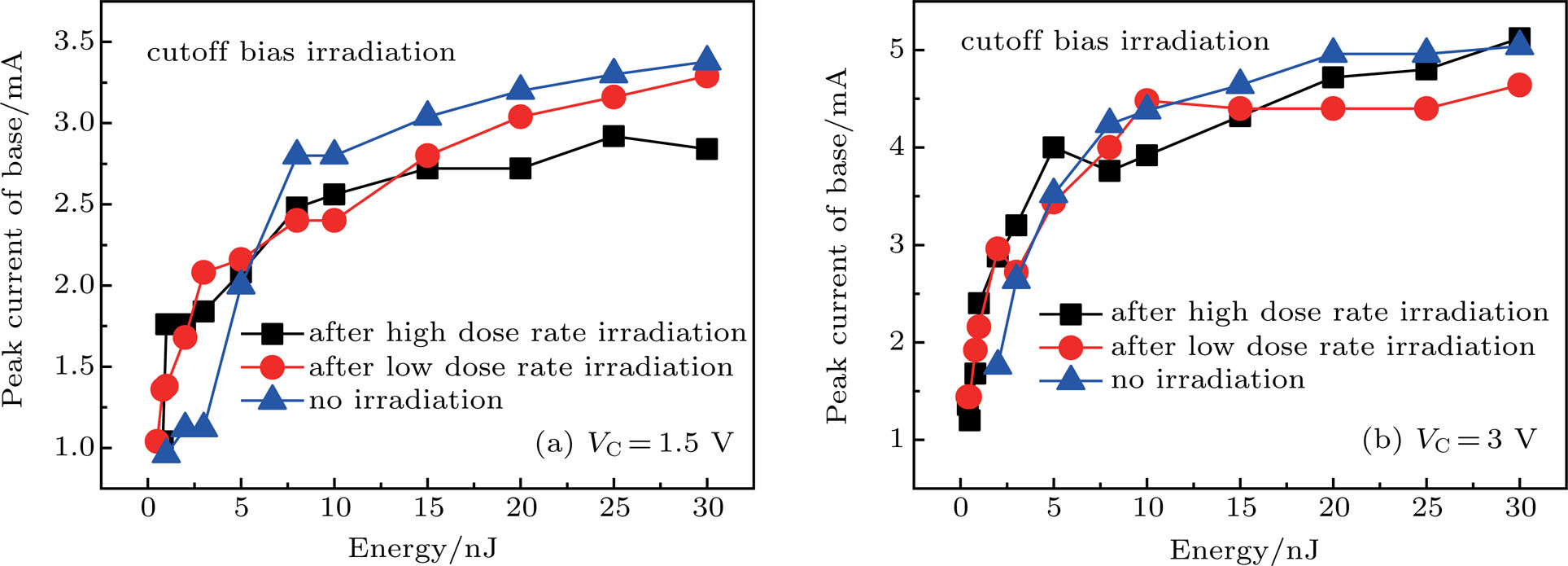 | Fig. 13. (color online) Plots of peak value of transient current of base versus energy of collector after being experienced by TID irradiation at cutoff bias with different dose rates. |
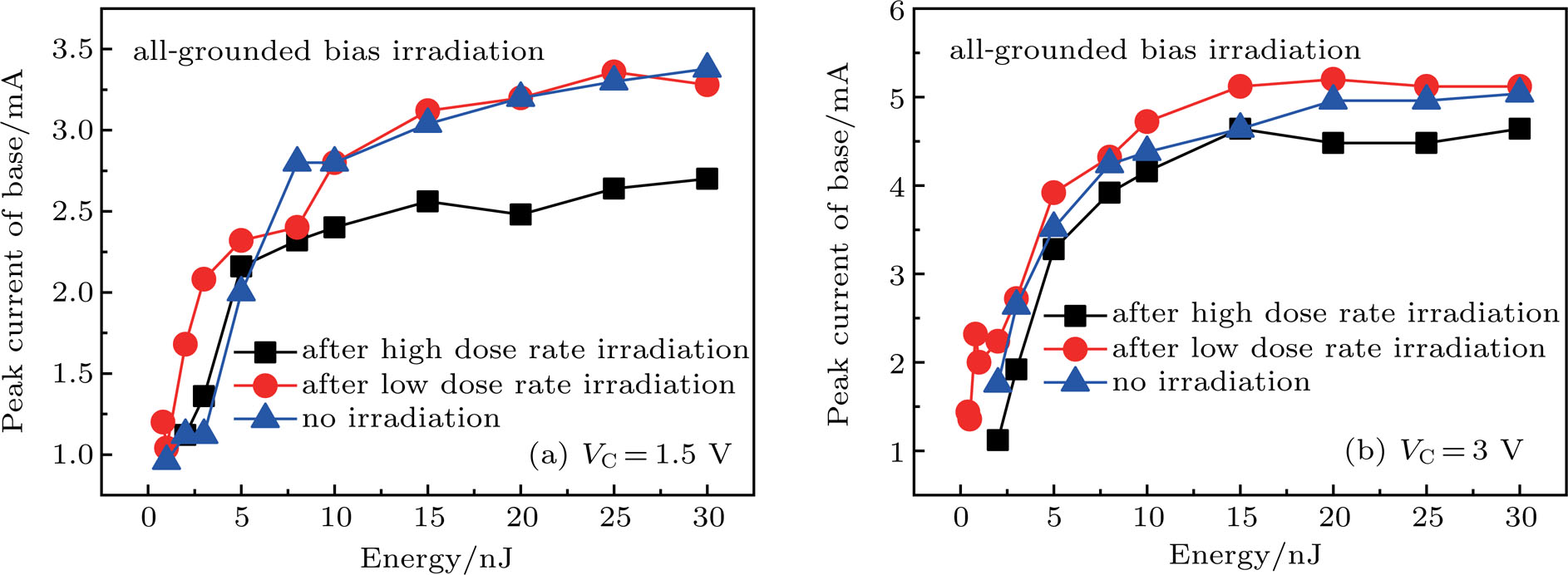 | Fig. 14. (color online) Plots of peak value of transient current of base versus energy of collector after being experienced by TID irradiation at all-grounded bias with different dose rates. |
As shown in Fig.
The applied voltages of VC = +1.5 V and VC = +3 V create electric fields at C/S and B/C junctions, and thus affect the carrier transport in the base region. Besides, carriers tend to an equilibrium state inside the transistor. Hence, the electron transient current of the collector has the same effect on the base hole current, and becomes a factor of the synergistic effect in base current. On the other side, the space electric field induced by oxide-trap charges in EB Spacer also limits the transport of holes in the base region.
For the γ irradiation of forward bias, the synergistic effect of the collector (in Subsection 4.1) indicates that deep level oxide-trap charges are formed in LOCOS near the base side by reverse bias of the B/C junction. The space electric field also offsets the drift effect on holes by an applied voltage of VC = +1.5 V in the base region. On the other hand, electron-holes need to be balanced inside transistors. Consequently, the response of base current transient (Fig.
Figures
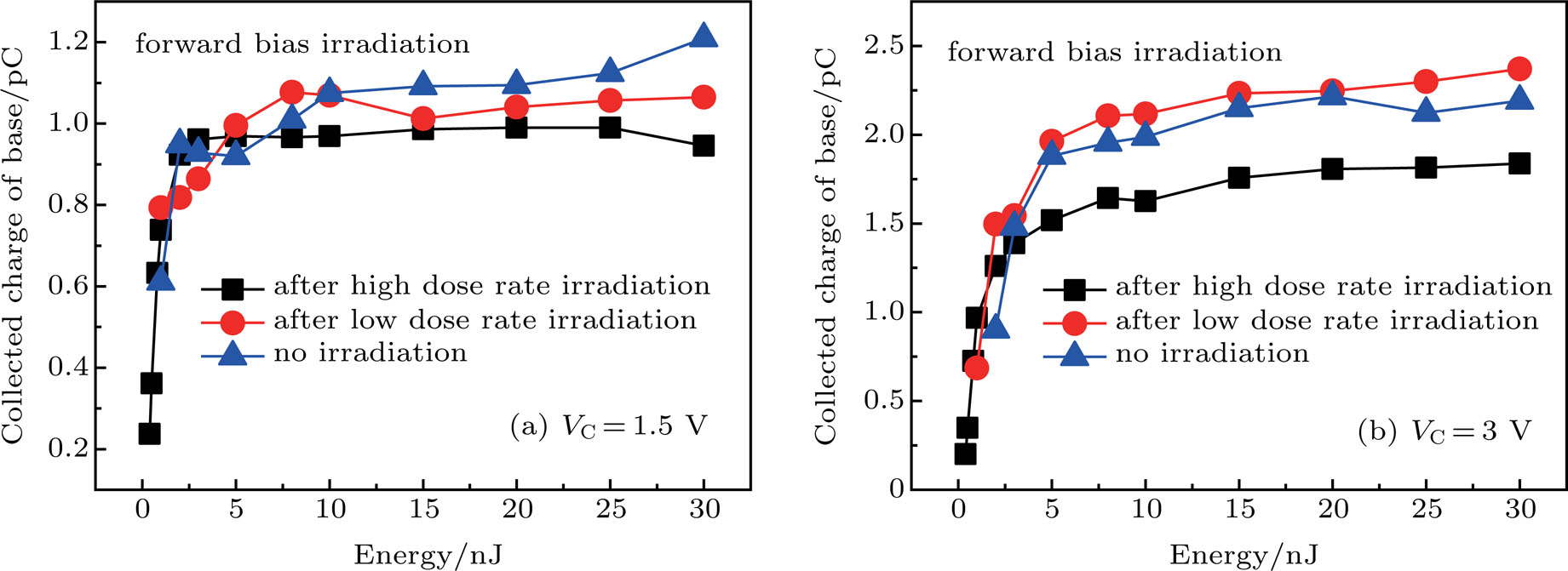 | Fig. 15. (color online) Plots of charge collection of base versus energy of the collector after being experienced by TID irradiation at forward bias with different dose rates. |
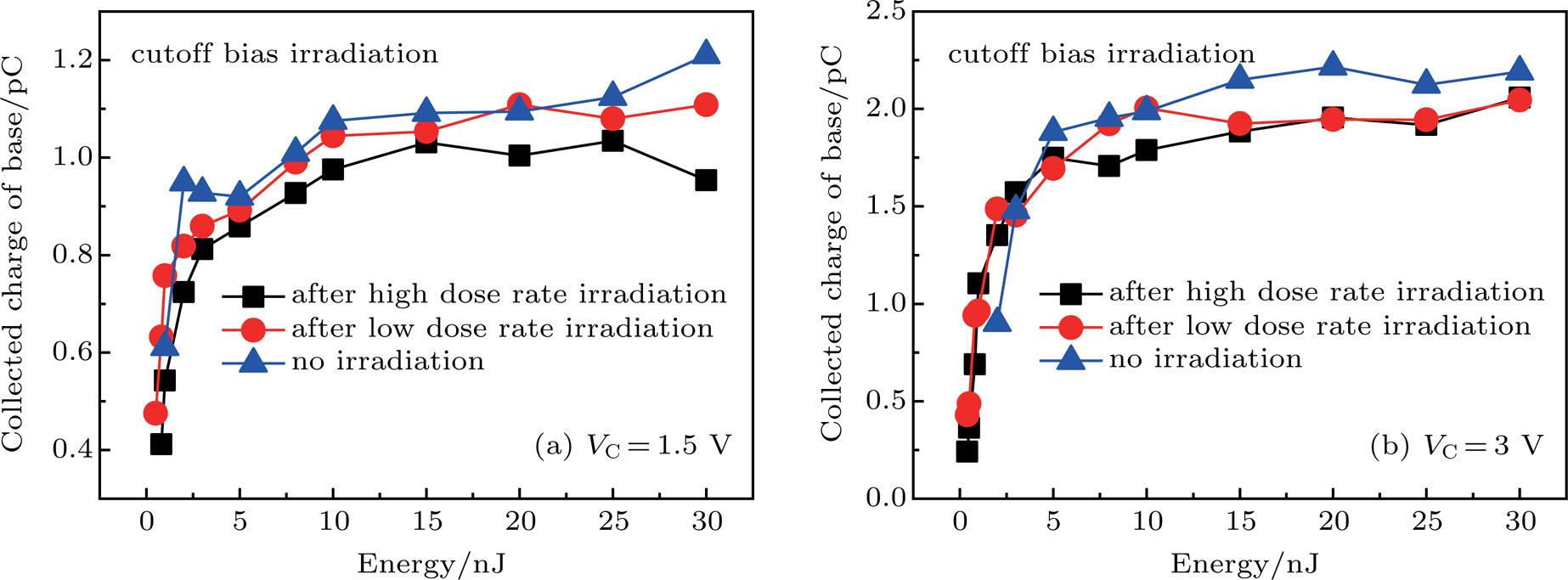 | Fig. 16. (color online) Plots of charge collection of base versus energy of collector after being experienced by TID irradiation at cutoff bias with different dose rates. |
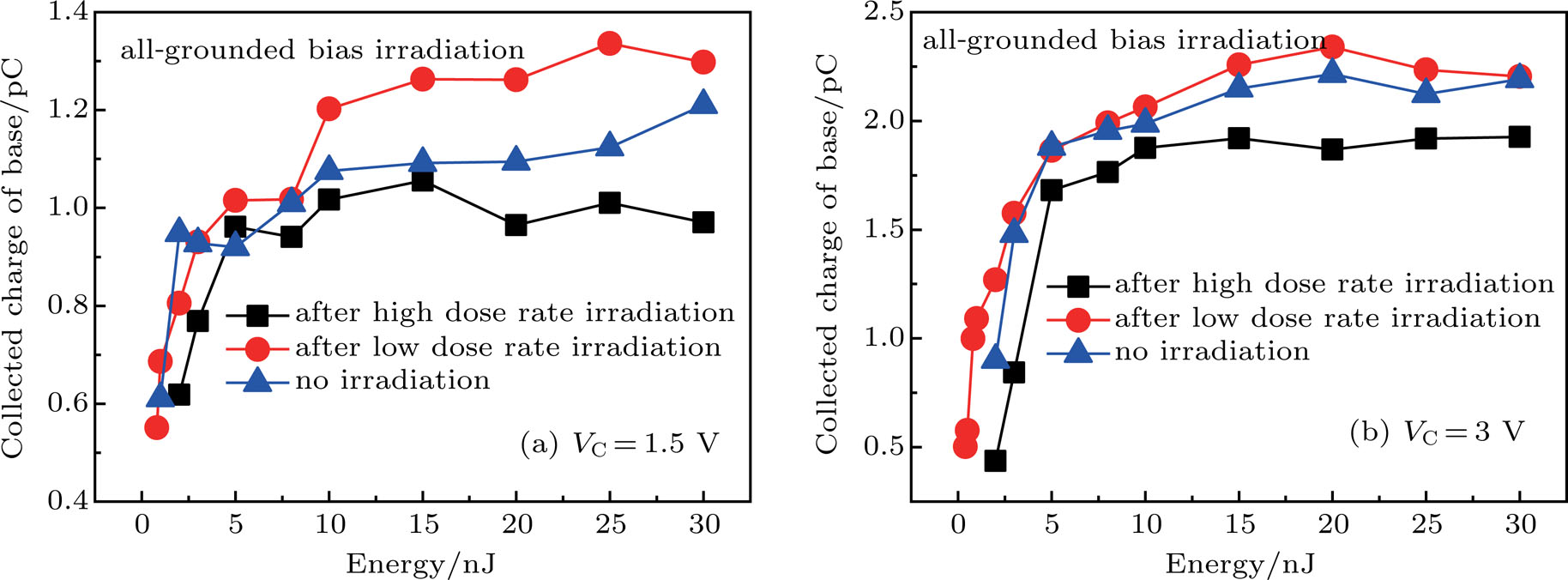 | Fig. 17. (color online) Plots of charge collection of base versus energy of collector after being experienced by TID irradiation at all-grounded bias with different dose rates. |
The base charge collection is primarily affected by the electric field at the B/C junction, resulting in the same response as the base current. In addition, in view of the very thin base region in the SiGe HBT, the defects induced by TID in the EB Spacer also have a nonnegligible effect on the transport of holes on the intrinsic base.
As seen in Fig.
Because there is no electric field in the SiGe HBT for all-grounded bias irradiation, the protons have a higher probability of being released to form interface traps while the ionized holes slowly transport at low dose rate irradiation (Fig.
In this work, we have carried out the microbeam laser tests to simulate SEE in the SiGe HBT after being experienced by 60Coγ irradiation with high and low dose rates, respectively. The synergistic effect of TID on SEE in SiGe HBT is investigated. The results show that the synergistic effect of SiGe HBT is not only related to bias conditions and dose rate of TID irradiation, but also is affected by the pulsed laser energy and applied voltage of SEE test. The characteristics of the synergistic effect in the SiGe HBT are as follows.
(i) The differences among synergistic effects in various samples are clearly observed when the applied voltage is small in the SEE test (VC = +1.5 V), but are not significant when the applied voltage is large (VC = +3 V).
(ii) The SEE response presents the difference between irradiated and un-irradiated SiGe HBTs when the pulsed laser energy is larger than 5 nJ.
(iii) In general, the transient current and charge collection of the un-irradiated SiGe HBT are more serious than those of γ irradiated devices. The γ irradiations at forward and all-grounded biases have an appreciable effect on SEE in the SiGe HBT, but the influence of TID irradiation at cutoff bias on the synergistic effect is not obvious.
(iv) The effect of positive oxide trap charges induced by TID on the distortion potential of SEE is the major factor for the synergistic effect. Moreover, the recombination of interface traps also plays a role in charge collection by diffusion.
The research results indicate that the γ irradiation has a possibility of mitigating the SEE damage in the SiGe HBT. Meanwhile, our previous researches have found that there is no apparent failure of the SiGe HBT when the total dose accumulates and reaches to 1 Mrad (Si). The TID damage of forward bias irradiation is weakest.[10] Consequently, this work also provides new ideas and research basis for the radiation hardening of SEE in the SiGeHBT.
| [1] | |
| [2] | |
| [3] | |
| [4] | |
| [5] | |
| [6] | |
| [7] | |
| [8] | |
| [9] | |
| [10] | |
| [11] | |
| [12] | |
| [13] | |
| [14] | |
| [15] | |
| [16] | |
| [17] | |
| [18] | |
| [19] | |
| [20] | |
| [21] | |
| [22] |


